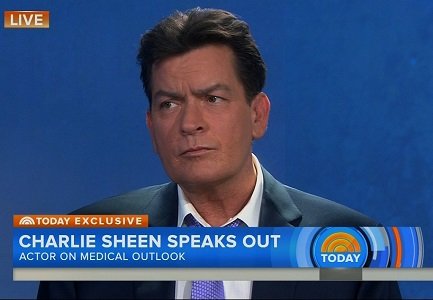(CNN) — Actor Charlie Sheen announced this week that he has HIV, but in the four years since his diagnosis, he said, he’s always shared his status with sexual partners.
Sheen said in a “Today” show interview that he’d had unprotected sex with two people since his diagnosis and it was “impossible” that he’d transmitted the virus to others. Sheen’s doctor, Robert Huizenga, who joined him for the interview, said the 50-year-old actor started taking antiviral therapy after he was diagnosed with HIV, which has reduced his viral load.
It is not impossible for Sheen to infect others, but it is “incredibly low,” said Huizenga, an assistant professor of clinical medicine at UCLA.
Indeed, there’s still stigma around HIV, but with the right precautions, people with HIV can still have sex safely, experts said.
“Patients who have HIV can certainly have sex. What’s important is that they do several things to decrease the risk of transmission,” said David Rosenthal, medical director of the Center for Young Adult, Adolescent and Pediatric HIV at North Shore-LIJ Health System in Great Neck, New York.
The first thing is to decrease a patient’s viral load, or the amount of HIV in the blood, semen and other bodily fluids, by taking antiretroviral therapy.
“The less amount of virus floating around in one’s system, the less chance of giving it to someone else,” Rosenthal said.
HIV is spread through sex — primarily anal and vaginal sex, but oral sex also carries risk. The other common way to spread the virus is through sharing needles, syringes and other injection-drug paraphernalia.
Antiretroviral therapy is a combination, or cocktail, of three or more medications that block the virus from replicating. The therapy has become much more simple for patients over the years — whereas they used to take 15 pills twice a day, they might now only have to take one pill once a day, Rosenthal said.
“If you’re able to get the viral load low, below the level of detection in lab tests, it’s very unlikely to transmit the virus. Not impossible, but very unlikely. The risk is far less than 1%,” said Dr. Stephen Boswell, president and CEO of Boston’s Fenway Health, a health care organization that works with lesbian, gay, bisexual and transgender people.
It can be hard for some patients to get their viral load below the level of detection using therapy, Boswell said. They have to be diagnosed early in their infection and take the medication every day, which can be a challenge. “It’s very hard for people to take a pill day in and day out and not miss a dosage,” he said.
Even if people with HIV are on therapy, and especially if they are not, Rosenthal recommends using condoms or other types of barrier protection during sex. This can include female condoms or dental dams. Latex condoms can prevent HIV transmission, but lambskin condoms are not effective for protecting against the virus.
Barrier protection is particularly important for people who miss doses of their therapy or in cases where the virus develops resistance, or finds ways to replicate even in the presence of antiretroviral drugs, Rosenthal said.
“Each thing that you do adds an additional level of decreased transmission risk,” Rosenthal said.
Although it is hard to know exactly how much condoms reduce the risk of HIV transmission, research suggests they bring down the risk about 80%. One study of heterosexual couples found that people with HIV were about 78% less likely to infect their partner if the couples reported regularly using condoms compared with those who did not.
Patients who have HIV can also reduce the risk of transmitting the virus by telling their sexual partners about their status so they can also make choices about how to protect themselves, Rosenthal said.
People who do not have HIV have the option of taking Truvada, a type of pre-exposure prophylaxis or PrEP that can reduce their risk of becoming infected by up to 96%. Truvada, which was approved by the U.S. Food and Drug Administration in 2012, is a pill taken once a day. It’s recommended by the CDC for HIV-negative individuals who are at high risk, such as those in a relationship with someone who is HIV positive.
“Often I see patients that are in multiple relationships with multiple different people and they choose to start PrEP to keep themselves safe from HIV,” Rosenthal said. Likewise, PrEP can help those who are in a committed relationship with someone who has HIV.
Although Sheen said in the “Today” interview that he told all his sexual partners about his HIV diagnosis, Sheen’s ex-girlfriend, Bree Olson, told the “Howard Stern Show” on Tuesday that she learned about it only in the past few days. The couple lived together in 2011, the year Sheen was diagnosed. According to Olson, they had sex almost daily for a year using lambskin condoms, which are not recommended for disease protection.
Sheen’s representative, Larry Solters, said he had no comment.
The-CNN-Wire
™ & © 2015 Cable News Network, Inc., a Time Warner Company. All rights reserved.
